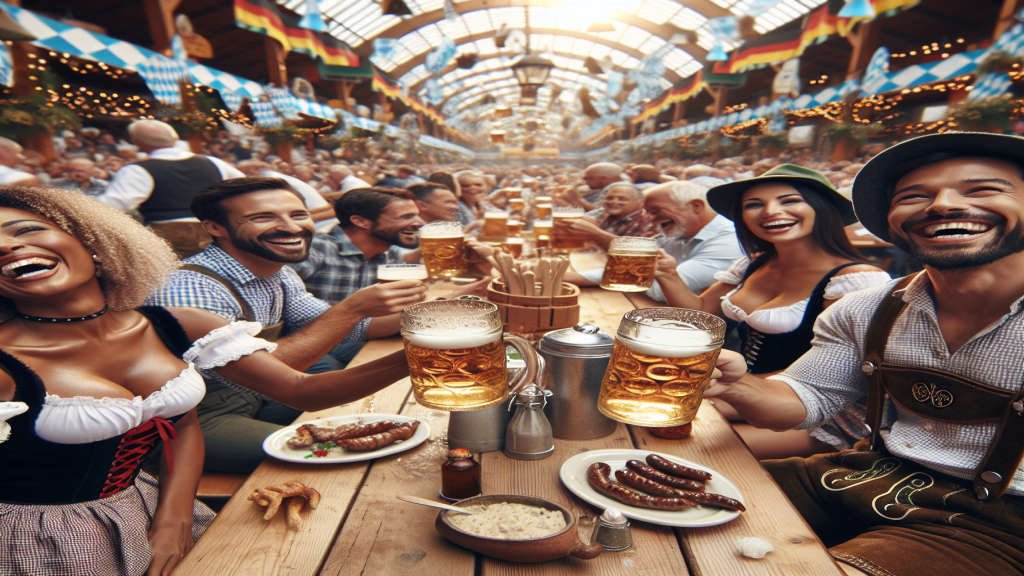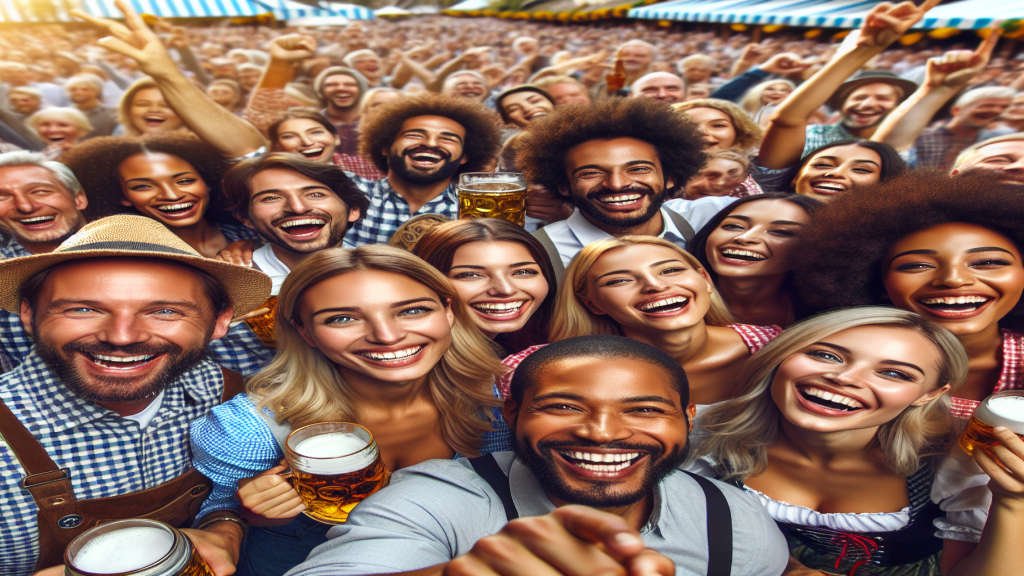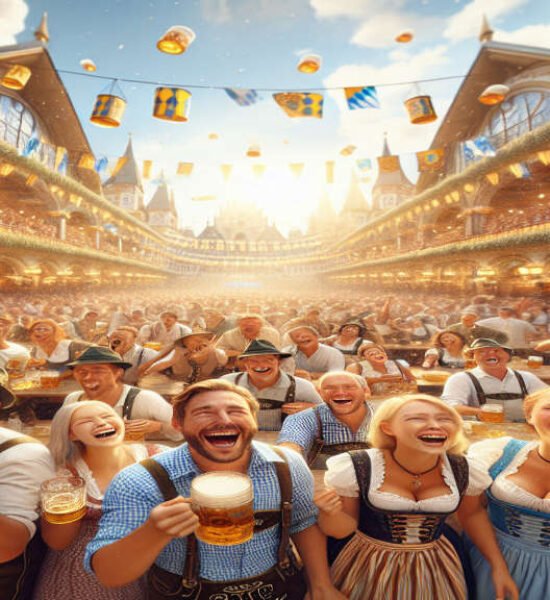Hey there, fellow festivity aficionado! Are you ready to strap on your lederhosen and dive into the jubilant world of Oktoberfest? If you’re eager to discover everything about Oktoberfest, you’ve come to the right place. Join me as we embark on a frothy journey through the rich Oktoberfest history, revel in the vibrant Oktoberfest traditions, and clink our glasses to the iconic Oktoberfest beer. Whether you’re a seasoned Oktoberfest enthusiast or a curious newcomer, this blog post will guide you through the merry intricacies of this legendary Oktoberfest celebration, complete with authentic Oktoberfest costumes and foot-tapping Oktoberfest music. Prost to that!
Main Points
- The origins and history of Oktoberfest
- Traditional customs and garb associated with the celebration
- The significance of beer and brewing in Oktoberfest festivities
- Music and entertainment that define the Oktoberfest spirit
- Modern interpretations and global influence of Oktoberfest
“`
The Origins and Evolution of Oktoberfest: A Historical Overview
Gather ’round, friends, and let’s take a whimsical wander down history lane to explore the roots of the world’s favorite autumnal bash—Oktoberfest! This legendary fest is not just about clinking steins and chowing down on pretzels; it’s a vibrant tapestry woven with rich Oktoberfest history, brimming with fascinating tales and traditions. So, put on your lederhosen or dirndl and dive into the merry old origins of this epic festival.
Unpacking the History
It all kicked off with a royal wedding in 1810, when Munich celebrated the nuptials of Prince Ludwig and Princess Therese. Little did they know, their grand party would evolve into an annual extravaganza of fun. Through wars, prosperity, and changes in culture, Oktoberfest adapted and grew, swinging its doors wide open to millions of revelers from around the globe who cherish the event’s legacy.
Traditional Treasures
Ah, the heartwarming traditions! The festival’s tapestry is threaded with time-honored customs that make the experience truly unforgettable. Here’s a little taste of those rituals:
- Oktoberfest Traditions: From the Mayor’s first keg tap to the vibrant parade of tent proprietors and the cozy, sing-along-filled beer tents—these rituals are the soul of the festivity.
- Parades and Costumes: Historical processions showcase splendid costumes and horses decked in regalia, enveloping the streets of Munich in a festive cloak of yesteryear charm.
- Authentic Grub: Belly up for a smorgasbord of Bavarian delicacies. Think succulent sausages, delicious pretzels, and scrumptious roast chicken—all staples of the Oktoberfest menu.
Beer: The Golden Thread
Now, what’s Oktoberfest without the legendary Oktoberfest beer? This golden nectar, flowing like rivers through the festival grounds, is brewed within Munich’s city limits according to the time-honored Reinheitsgebot (Beer Purity Law). Each brew unique, capturing the essence of the festivities in every sip! So, raise your mug to the centuries of brewing mastery that saturate this wondrous occasion.
There you have it, dear reader—the nutshell of Oktoberfest’s storied past. It’s a festival that warms the heart and lifts the spirit, drenched in history and frothy delight. Prost to the memories still to be made!

Cultural Significance: The Role of Oktoberfest in Bavarian Traditions
Hey, friend! Let’s chat about the heart of Bavarian culture—the legendary Oktoberfest. Every year, this grand fest pitches its tents in Munich, wrapping everyone in a warm embrace of tradition. It’s more than just a party; it’s a time capsule of customs passed down through the ages. Here, everyone slips into their Oktoberfest costumes with pride, the men in Lederhosen and the ladies in Dirndls, becoming a sea of Bavaria’s finest!
More Than Beers and Cheers
It’s not just the clinking of beer mugs that brings folks together—oh no! The Oktoberfest music plays a pivotal part, where lively tunes from oompah bands get your feet tapping. Imagine being surrounded by music so hearty it echoes through the festive air, urging even the shyest souls to dance. This mix of merriment, heritage, and pure joy? That’s the true essence of Oktoberfest, serving as a timeless thread in the fabric of Bavarian traditions.
Steins, Lederhosen, and Dirndls: The Iconic Symbols of Oktoberfest
Gather ’round, friends! It’s time to dive into the heart of Oktoberfest, where tradition meets revelry. Think Oktoberfest, and images of hefty steins brimming with golden beer come to mind, alongside folks prancing about in charming lederhosen and flouncy dirndls. Let’s unravel the magic behind these symbols that transform Munich into a frothy, festive wonderland every autumn. Because, when you’re clinking glasses and swaying to oompah tunes, you’re not just at a party, you’re part of a centuries-old cultural phenomenon!
Everything About Oktoberfest
Every symbol, from the sturdy steins to the snug lederhosen, spins a yarn of history and culture. These aren’t just fancy dress costumes; they’re a nod to the Bavarian way of life that has been the soul of Oktoberfest since its inception in 1810. So, let’s raise our glasses (carefully, those steins can be heavy!) and say ‘Prost!’ to the iconic traditions that make Oktoberfest the unforgettable jamboree it is today!
From Local Festivity to Global Phenomenon: The Spread of Oktoberfest Celebrations
Hey there, fellow Oktoberfest enthusiasts! Have you ever wondered how our beloved Oktoberfest, which started in a cozy corner of Munich, Germany, became the worldwide excitement it is today? It’s a story of cultural charm, hopping over borders with a stein in hand, turning a local festivity into an international sensation. Pull up a chair and let’s dive into this remarkable journey!
The Humble Origins
Once upon a time, in 1810, the first Oktoberfest was a royal wedding celebration. Little did they know, it would spark a tradition making Munich the place to be every autumn.
The Global Hopping Begins
Fast-forward a couple of centuries, Oktoberfest’s spell has been cast far and wide. Here’s how it spread its merry wings:
- German Communities Abroad: This festivity took flight with Germans setting up new lives overseas, taking their love for bratwurst and beer with them.
- Cultural Exchange: As travelers soaked up the vibrant culture in Munich, they returned home with tales of lederhosen, lively polka, and the urge to recreate the fun.
- Commercial Opportunities: Breweries and festival organizers spotted a golden opportunity to captivate crowds and Oktoberfest-themed events became a hit.
The World Joins the Party
And so, the Oktoberfest vibe now rocks every corner of the globe, from the Americas to Asia, making friends and memories. It’s not just about the beer (well, not entirely), it’s about that joyous spirit that unites us all. Cheers to Oktoberfest, where every clink of a mug echoes a piece of Munich, and every polka step celebrates our global village!
The Culinary Delights of Oktoberfest: A Taste of German Festive Cuisine
G’day, mates! Ever wondered what makes Oktoberfest a feast for the taste buds? It’s a time when German cuisine shines, offering a smorgasbord of flavors that capture the festive spirit. Imagine biting into a juicy Bratwurst or savoring the tang of sauerkraut — these are moments that define the culinary adventure of Oktoberfest. Each dish is a celebration, steeped in tradition and heartwarmingly delicious. So, pull up a seat and let’s dive into the hearty goodness that this vibrant festival has to offer!
Traditional German Eats to Whet Your Appetite
Get ready to roll up your sleeves, because when we talk about festive cuisine, Oktoberfest doesn’t play by halves. From pretzels that twist and turn like the German Alps to Schnitzel that’s as crispy as an autumn leaf, this is more than just food; it’s a cultural journey on a plate. And let’s not forget about the liquid gold – beer – that flows like the Danube, pairing perfectly with every lip-smacking dish. So, what are you waiting for? Come join the banquet and become a part of this scrumptious narrative!
Oktoberfest Today: Innovations, Challenges, and the Future of the World’s Largest Volksfest
Howdy, friends! Have you ever wondered what makes Oktoberfest the talk of the globe? Well, it’s not just the frothy beers and the clinking steins, but the festive innovations that keep this heritage alive! At its heart, Oktoberfest remains a traditional Volksfest, but it’s constantly evolving. Let’s peer into the techno tents where the old meets new, giving Oktoberfest that spark of modern flair!
Innovations Keepin’ It Fresh
The Bavarian bash has seen nifty tech from high-speed connectivity to cashless payments, creating a smooth experience for all. But, that ain’t all! There’re eco-friendly efforts, like reusable cups, making a big green impact. It’s a blend of honoring tradition while embracing change, that keeps our beloved fest at the pinnacle of popularity.
Challenges Brewing
Yet, it’s not all cheers and toasts. Oktoberfest faces challenges such as crowd management and maintaining its cultural essence amidst globalization. Safety and sustainability are key concerns that are being tackled head-on by festival organizers. They’re juggling to keep the soul of the fest while ensuring everyone’s having a grand ol’ time.
The Future Looks Frothy
Looking ahead, the picture for Oktoberfest is as bubbly as a fresh pour. The focus on innovation, tradition, and sustainability suggests a bright future. It’s not just about keeping up; it’s about leading the way in festival fun and cultural splendor.
“Oktoberfest is a canvas of tradition painted with the colors of innovation.”
So, grab your lederhosen and join the millions under the Bavarian sky to witness the future of the world’s largest and arguably most cheerful Volksfest. Prost to that!
Conclusion
In conclusion, Oktoberfest is not merely an autumnal festival; it is a vibrant tapestry woven with the threads of history, tradition, and cultural pride. From its humble origins as a royal wedding celebration to its current status as a global phenomenon, this festivity has stood the test of time, continually adapting and evolving while retaining its core essence. Everything about Oktoberfest, from the clinking of beer steins and the aroma of sizzling bratwurst to the jubilant sounds of traditional folk music and the laughter-filled shouts of “Prost!”, embodies a spirit of camaraderie and joy. Whether you’re donning a dirndl or lederhosen for the first time or you’re a seasoned veteran of the festivities, the heart of Bavarian culture beats strong beneath the festival tents of Munich. As the Oktoberfest comes to a close each year, it leaves behind a trail of fond memories and an eager anticipation for its return, underscoring its enduring legacy and the universal appeal of celebrating life and heritage with warmth and gusto.
Frequently Asked Questions
What is Oktoberfest?
Oktoberfest is the world’s largest Volksfest (beer festival and travelling funfair) held annually in Munich, Bavaria, Germany. It typically starts in late September and ends on the first Sunday in October.
Do I need to book a table at Oktoberfest?
It’s recommended to reserve a table if you’re planning to attend with a large group, especially on weekends or public holidays. However, there are also areas for walk-in visitors.
What should I wear to Oktoberfest?
Traditional attire is encouraged but not mandatory. Many men wear Lederhosen, and women wear Dirndls. Comfortable clothing and shoes are advised due to the festival’s duration and nature.
Can children attend the Oktoberfest?
Yes, children can attend the Oktoberfest. There are days with special offers for families, and many rides and activities suitable for children. However, the beer tent atmosphere may not be suitable for young children, especially in the evenings.
How do I get to Oktoberfest?
Oktoberfest is easily accessible by public transportation in Munich. You can take the S-Bahn (city trains), U-Bahn (subway), Trams, or buses. The closest subway stations are Theresienwiese and Goetheplatz.




